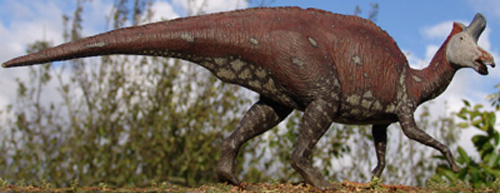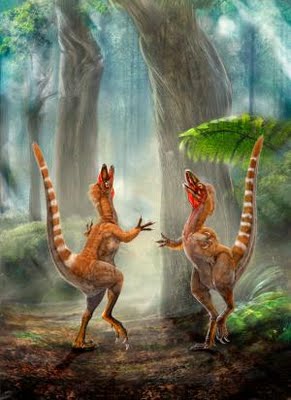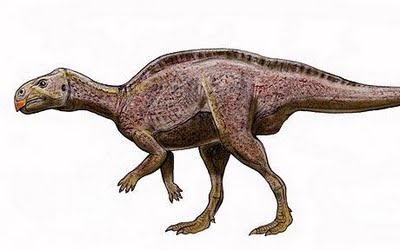Rareresource
Saturday, February 27, 2010
Prehistoric island 'Jurassic Parkette' ruled by dwarf dinosaurs
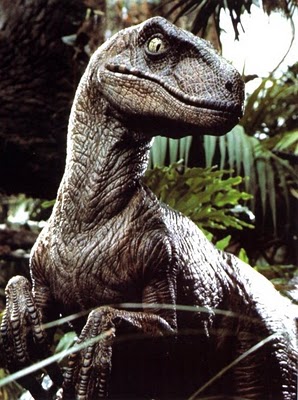
Paleontologists have found out a prehistoric "lost world" which was ruled by miniature Dinosaurs. Sort of a pigmy Jurassic Park, the island was the hometown of dinos who were up to 8 times smaller than some of their mainland cousins, reports the Telegraph.
Dwarf Dinosaur fossils were discovered in what is now modern day Romania, in an area known as Hateg, which, 65 million years before - when the creatures were living there - was an island, reports The Telegraph.
One of the fossils was of Magyarosaurus, which was slightly bigger than a horse, but was related to some of the biggest creatures to ever walk the Earth - gigantic titanosaurs such as Argentinosaurus, which reached up to 100 feet long and weighed around 80 tons.
Professor Michael Benton, from the University of Bristol, who carried out the research with scientists at the Universities of Bucharest of and Bonn, said: "Most of the famous dinosaurs that we know about were living on big landmasses at the last part of the Cretaceous period.
The curious thing about Europe at this time was that it was mostly covered by sea and much Eastern Europe was a sort of archipelago of islands.
If you are a gigantic dinosaur on a small island with limited food and space, then the evolutionary pressure is either to go extinct or to get smaller.
The discovering will be published in the scientific journal Palaeogreography, Palaeoclimatology, Palaeoecology.
Labels: Dinosaur unit, Dinosour age, Dinosour history, Dinosour world, New Dinosaurs
Friday, February 26, 2010
World's largest group of dinosaur footprints discovered in Shandong
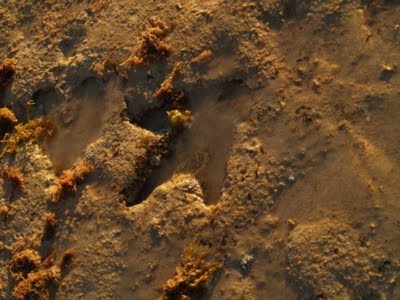
At present, a large group of Dinosaur footprints were discovered at Zhucheng city, Shandong province.
Paleontologists from Chinese Academy of Sciences and Chinese Academy of Geological Sciences came to the location and verified the collection to be the largest ever discovered.
The group of footprints is located in an area of more than 2,600 square meters, and more than 3,000 footprints of different kinds of dinosaurs emerge in various shapes and sizes.
This is another significant discovery that follows the discovery of world's largest group of Dinosaur Fossils in the same city.
Labels: Dinosaur unit, Dinosour age, Dinosour history, Dinosour world, New Dinosaurs
Thursday, February 25, 2010
Island of dwarf dinosaurs did exist
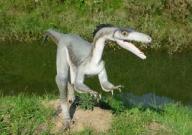
An island of "dwarf dinosaurs" which was only a theory for 100 years really did survive, scientists have announced.
The idea of the tiny prehistoric beasts on Hateg Island, Romania, was proposed 100 years before by the colourful Baron Franz Nopcsa, whose family owned estates in the area.
He discovers that many dinosaur remains on Hateg were half the size of their close relatives in older rocks in England, Germany, and North America.
The baron's theory has been checked for the first time by Professor Mike Benton at the University of Bristol, and six other authors from Romania, Germany, and the United States.
The team found that the Hateg Island dinosaurs were in fact dwarfs and not just young dinosaurs.
A favourite theme of evolutionary ecologists is whether there is an "island rule" - where gigantic animals isolated on islands evolve to become smaller.
Three species of the Hateg dinosaurs - the plant-eating sauropod Magyarosaurus and the plant-eating ornithopods Telmatosaurus and Zalmoxes - are half the length of their close relatives elsewhere.
The team examined these three dinosaurs, each of them represented by many specimens. They found no evidence of any large bones such as they would expect to locate in their normal-sized relatives.
More importantly, a close study of the bones proved that the Dinosaurs had reached adulthood so they were not just underdeveloped youngsters.
Labels: Dinosaur animals, Dinosaur fossil pictures, Dinosaur reptile, Dinosaurs research, Walking with Dinosaurs
Wednesday, February 24, 2010
Giant skulls discovered at Utah's Dinosaur Monument a 'fortuitous' find
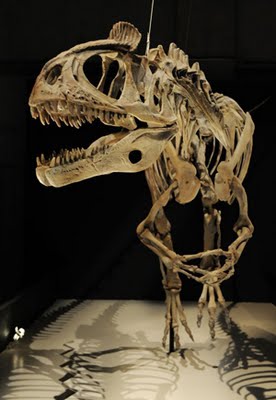
Scientists, such as Dan Chure, refer to sauropods, the gigantic, long-necked plant-eating Dinosaurs, as "headless wonders."
Not only are their noggins puny in relation to their colossal bodies, but very hardly do paleontologists ever recover entire sauropod skulls, said Chure, of Dinosaur National Monument. But a fresh species unearthed at the monument several years before was identified from four skulls - two fully intact - found within a few feet of each other.
Abydosaurus mcintoshi was recognized to the world Tuesday in the German science weekly Naturwissenshaften, where Chure published findings with Brigham Young University collaborators. The new sauropod is supposed to be a distant descendant of brachiosaurus, which roamed Utah 150 million years before.
Discovering just one skull would be impressive, but four is beyond what any Dinosaur hunter could hope for. The skulls revealed jaws crammed with dozens of minute teeth.
"It's a fortuitous thing. In numerous dinosaurs, the bones of the head do not fuse up, especially in sauropods. You have an array of components that are held collectively by soft tissue. The only thing that resides together is the brain case," said Brooks Britt, a BYU geology professor.
National Park Service employees initially discovered an interesting cache of bones near the monument's visitor's center in the late 1990s and enlisted Britt's help to prepare the specimens.
The monument is well-known for Dinosaur Discoveries made in late-Jurassic-era Morrison Formation. But these new bones were in the younger Cedar Mountain Formation, a 105-million-year-old sandstone that dates the bones to the middle of the Cretaceous, the 3rd and final chapter of dinosaurs' reign that ended 66 million years ago.
After the initial find, park staff delivered a 3-ton block to BYU's Museum of Paleontology.
Labels: Dinosaur unit, Dinosour age, Dinosour history, Dinosour world, New Dinosaurs
Tuesday, February 23, 2010
Scientists decipher dinosaur colouration
Labels: dinosaur age, Dinosaur fossil pictures, Dinosaur fossils, Dinosaur unit
Monday, February 22, 2010
Primitive island 'Jurassic Parkette' ruled by dwarf dinosaurs found
Labels: dinosaur age, dinosaur history, dinosaurs family, Dinosaurs world
Saturday, February 20, 2010
Science Uncovers What Dinosaurs Really Looked Like
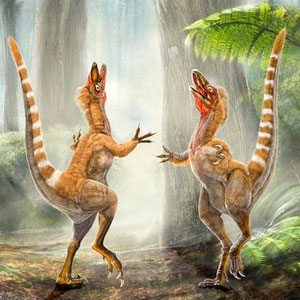
Scientists have wonderful powers. They can really go back in time and tell you what Dinosaurs look like. They can notify you where plants and babies come from. They’re similar to wizards in labcoats.
The most latest development? Scientists have decoded the complete-body patterns of a dinosaur, so you can see what it really looked like while it was breathing. And boy, does it seem to be kinda weird. Like something you’d fight in opposition to a Soul Caliber game, or a gigantic turkey that frequents dark Hollywood clubs and raves. Basically, totally bizarre.
How did they perform this? How did they dig up the cosmetology secrets of the dinosaurs that are not live and gone? They took pigments from protofeathers and examined them heavily. So the foremost dinosaur we have in complete color is the 155-million-year-old Anchiornis huxleyi. It seems like an irritable chicken-monster that will peck out your eyes in your sleep. It seems like Lady Gaga’s guard dog.
My question is, if science has been capable of colorizing dinosaurs, how long is it until we’ll be able to clone them? I predict at the most, two years, at which point you’ll be able to get teacup dinosaurs as house-pets, and try to make sure they don’t shred your pillows that you bought at Barney’s.
Labels: Dinosaur picture, Dinosaurs games, Dinosour world, New Dinosaurs
Friday, February 19, 2010
Dinosaur 3D movie screens at IMAX theatre
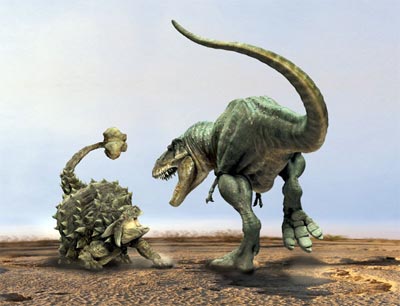
Dinosaurs persist to fascinate old and young alike, Christine Catt, marketing specialist at science north said.
“Dinosaurs Alive! 3D featuring the most ancient dinosaurs of the Triassic Period to the monsters of the Cretaceous, reincarnated and life-sized for the giant IMAX screen, is now playing,†Catt said.
“From the exotic, trackless expanses and sand dunes of Mongolia’s Gobi Desert to the dramatic sandstone buttes of New Mexico, the film will pursue American Museum of Natural History paleontologists as they explore some of the greatest dinosaur finds in history.â€
The film is presented in English and French, Catt added.
The movie is sponsored by a number of media companies, with Northern Life.
Labels: Dinosaur unit, Dinosour age, Dinosour cartoon, Dinosour family, Dinosour history
Thursday, February 18, 2010
Free of dinosaurs, birds gorged until flightless
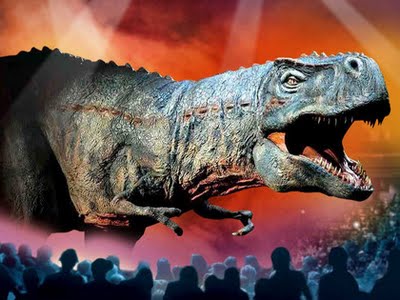
SPOILT for food and with their dinosaur predators recently extinct, few birds put on so much weight they became too fat to fly.
DNA examination of giant birds such as emus and ostriches, led by Australian National University's Matthew Phillips, discloses how birds such as the Australasian emu and cassowary, the now-extinct New Zealand moa, the South American rhea and African ostrich scattered around the globe.
The study proposes that flightless birds known as ratites were not necessarily relics of the super continent Gondwana - which drifted apart 100 million years ago to form continents including Africa, Australia and South America - but were able to fly to new lands.
Dr Phillips, an evolutionary biologist, said molecular dating had proposed that the ancestors of these birds became flightless independently about 65 million years ago, around the similar time Dinosaurs became extinct.
Life without dinosaurs not only eliminated a predator, the birds were left with more vegetation to feed on and could spend more time on the ground foraging without worrying about the need to fly from danger.
Labels: Dinosaur bones, Dinosaur picture, Dinosaurs games, Dinosaurs movie, New Dinosaurs
Wednesday, February 17, 2010
Montana students to study dinosaur eggs in China
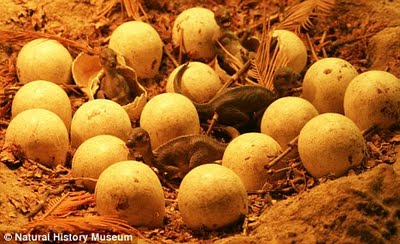
Nine Montana college students are programmed to be in China for six weeks this spring to learn Dinosaur eggs that have porous but thick shells.
Montana State University paleontologist Frankie Jackson states eight of the students are undergraduates and one is working on a master's degree. All the students are looking for careers in research.
Six of the undergraduates are from Montana State, one is from Rocky Mountain College and other from Dawson Community College.
An MSU graduate learner is already in China conducting research.
Jackson utters a $145,000 grant from the National Science Foundation is paying for the research.
Labels: Dinosaur unit, Dinosour age, Dinosour family, Dinosour history, Dinosour world
Tuesday, February 16, 2010
Did dinosaurs evolve from birds or birds from dinos?
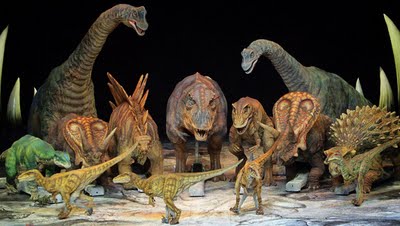
Study questions current evolutionary beliefs about birds
Latest study published in the Proceedings of the National Academy of Sciences proposes that Dinosaurs might actually have evolved from birds and not the other way around, as is commonly believed.
Oregon State University zoology professor John Ruben presents commentary about the study, which tested a latest specimen of raptor fossil discovered in 2003. The PNAS study reveled that the “small, feathered species must have been a ‘glider’ that came down from trees.â€
The general and long-held belief that raptors and other ground-dwelling dinosaurs ultimately became birds is brought into question by the research, which Ruben says presents sound evidence that birds eventually became certain types of dinosaurs. For instance, the velociraptor so prominent in Jurassic Park might really have been a flightless bird.
Analysis of the feathers on the “microraptor’s†four limbs implies that the dinosaur probably couldn’t have taken off for ground-up flight, but were probably gliding from trees, “somewhat like a modern-day flying squirrel.†Ruben says this analysis builds it improbable that dinosaurs one day took to the skies but, rather, that birds one day touched down and stayed put, finally becoming dinosaurs.
Labels: Dinosaur animals, Dinosaur reptile, Dinosaurs, Extinction of Dinosaurs, First dinosaur
Monday, February 15, 2010
New Species of Tyrannosaur discovered in Bisti Wilderness area
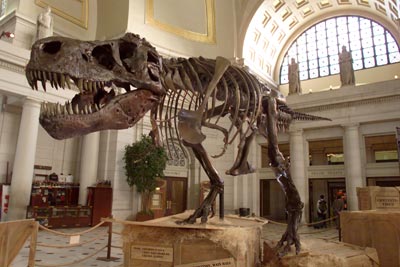
The finding of Dinosaur bones in the Bisti Wilderness area in 1998 was a significant find for paleontologists who uncovered what became dubbed the "Bisti Beast."
But 12 year after, the scientific community isn't just looking at more dinosaur bones in a museum. Rather, a new species of Tyrannosaur.
The discovery requires more than a decade to validate, but paleontologists applaud the find and honor the discovery as another breakthrough in evolutionary science.
The Bisti Beast at present has an official name: Bistahieversor sealeyi (pronounced bistah-he-ee-versor see-lee-eye). The skull is more than 1 meter long and the entire dinosaur stood more than 30 meters tall.
"Anytime they discover a different species, it opens up a new realm for working with evolution," said Sherrie Landon, Paleontologist Coordinator for the Bureau of Land Management Farmington Field Office.
The Bisti Wilderness is plush with other dinosaur, small mammal and reptile fossils, but federal regulations avoid most digs in the area.
"The only way anything's going to be exposed is if it's exposed naturally by wind and rain," said Bill Papich, spokesman for the Bureau of Land Management.
Only walking and hiking are allowed in federally designated wilderness areas, Papich said. Bicycling and other outdoor activities are banned, including excavations.
But researchers obtained a special authorization to do the dig in the 1990s.
The Bisti Beast roamed the wilderness area 74 million years before, said Thomas Williamson, curator of paleontology at the New Mexico Museum of Natural History and Science in Albuquerque, where the Tyrannosaur is on display.
Labels: Dinosaur unit, Dinosour age, Dinosour family, Dinosour history, Dinosour world
Saturday, February 13, 2010
Dwarf Dinosaurs existed on 'Neverland'-Like Island
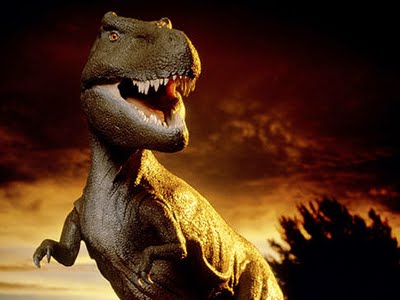 Dinosaurs on an island in Transylvania existed small and never really grew up.
Dinosaurs on an island in Transylvania existed small and never really grew up.
• Dwarf dinosaurs survived on a Late Cretaceous island, the latest analysis of bones confirms.
• Dwarf dinosaurs appear to have emerged from a process called progenesis, which reduces the developmental period.
• The dwarf dinosaurs existed fast, reaching sexual maturity at earlier ages than their mainland counterparts, and they likely died young.
When Hungarian baron Franz Nopcsa claimed that his sister in 1895 found out bones belonging to dwarf dinosaurs on his family's Transylvanian estate, many thought his claims were on par with Count Dracula fiction.
The latest study not only proves the existence of dwarf dinosaurs, but also explains how dinosaurs shrank during the Late Cretaceous at a Neverland-like place -- Hateg Island, Romania -- where dinos never really grew up.
According to the study, which has been accepted for publication in the journal Palaeogeography, Palaeoclimatology, Palaeoecology, the unusual phenomenon emerges to have only affected few of the island's dinosaur residents.
Labels: Dinosaur unit, Dinosour age, Dinosour history, Dinosour world, New Dinosaurs
Friday, February 12, 2010
Birds May Have Not Evolved from Dinosaurs
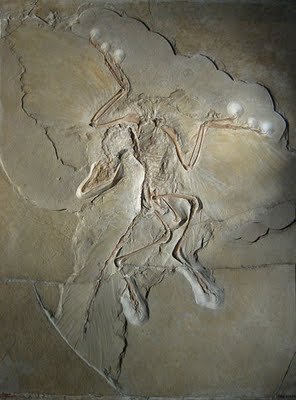
It might have been the other way around
Over the past few years, many scientific studies that refute the widely held idea that birds evolved from Dinosaurs have been published in different respected journals around the globe. Such is the case with a latest paper appearing in the latest issue of Proceedings of the National Academy of Sciences (PNAS), which throws added doubts on the decade-old idea.
What the researchers behind this investigation advise is that ground-dwelling theropod dinosaurs were not the source for the ancestors of modern birds. This work casts latest doubts on the established theory of how flight evolved.
Oregon State University Zoology Professor John Ruben is the author of the new research, which deals primarily with the fossil of a creature known as a microraptor that was exposed back in 2003. While studying a 3D model of the creature, Ruben and his team determined that its flying potential was only limited to gliding on variety of air currents from atop trees, and that the tiny animal was unable to fly on its own.
This paper is consistent with previous ones published in the field over the previous years, and Ruben believes that evolution may have actually derived some dinosaurs from birds, and not the other way around.
“We're ending by breaking out of the conventional wisdom of the last 20 years, which insisted that birds evolved from dinosaurs and that the debate is all over and done with . This issue isn't resolved at all . There are just too many inconsistencies with the thought that birds had dinosaur ancestors, and this newest study adds to that,†the expert says.
According to the theory developed at Oregon, it may be that birds and dinosaurs actually had a common ancestor, very much related to the common link between humans and primates. After the two types of animals split, dinosaurs and birds each developed their separate ways, with the winged creatures eventually giving birth to raptors as we know them today.
Labels: Dinosaur footprint, Dinosour cartoon, Dinosour family, Dinosour history
Thursday, February 11, 2010
Yale scientists complete colour palette of a dinosaur for the first time
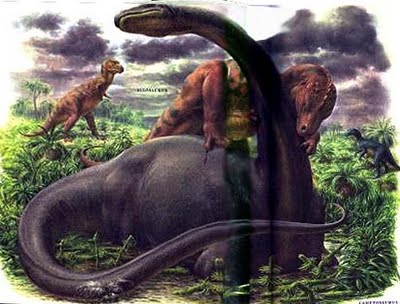
Deciphering microscopic clues buried within Fossils, scientists have uncovered the vibrant colours that adorned a Feathered Dinosaur extinct for 150 million years, a Yale University-led research team reports online Feb. 4 in the journal Science.
Unlike recently published work from China that inferred the existence of two types of melanin pigments in various species of feathered dinosaurs, the Science study analysed colour-imparting structures called melanosomes from an complete fossil of a single animal, a feat which facilitated researchers to disclose rich colour patterns of the entire animal.
In fact, the analysis of melanosomes conducted by Yale team was so precise that the team was able to allocate colours to individual feathers of Anchiornis huxleyi, a four-winged troodontid dinosaur that lived during the late Jurassic period in China. This Dinosaur sported usually grey body, a reddish-brown, Mohawk-like crest and facial speckles, and white feathers on its wings and legs, with bold black-spangled tips.
'This was no sparrow or crow, but a creature with a very notable plumage,' said Richard O. Prum, chair and the William Robertson Coe Professor of Ornithology, Ecology and Evolutionary Biology at Yale and a co-author of the study. 'This would be a very striking animal if it was alive today.'
The colour patterns of the limbs, which strongly look like those sported by modern day Spangled Hamburg chickens, probably functioned in communication and may have helped the dinosaur to attract mates, suggested Prum.
Labels: Dinosaur picture, Dinosaur unit, Dinosour age, Dinosour world, New Dinosaurs
Wednesday, February 10, 2010
Ancient dinosaur had stripes, researchers say
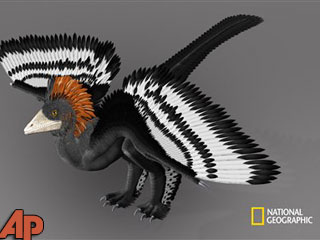
Some Dinosaurs had russet-colored feathers, and one jazzy specimen had a Mohawk crest and stripes, researchers say in the former reports to confidently assign colors to dinosaurs.
Their colors have long been a subject of speculation among school children and researchers.
In the latest study, reported in Thursday's online edition of the journal Science, scientists focused on melanosomes, which impart color.
They were able to assign color to individual feathers and thus work out color patterns for the entire Fossil of Anchiornis huxleyi, a small, feathered, two-legged dinosaur that lived approximately 150 million years ago.
The animal would have weighed about four ounces (110 grams) and emerges to have had a dark gray or black body and wings with some white feathers that gave it a stripe pattern, plus a reddish-brown crest and speckles on the face.
"This was no crow or sparrow, but a creature with a very remarkable plumage," said Richard O. Prum, professor of ornithology at Yale University and a co-author of the study.
"This would be a very striking animal if it was alive at present," Prum said in a statement.
The specimen they studied was originated in China, which was also the home 125 million years ago of Sinosauropteryx, a creature that seems to have had russet-colored feathers, according to a paper published previous week in the journal Nature.
Prum speculated that the color pattern of A. huxleyi could have served as a signal to attract mates.
Co-author Julia Clarke, an associate professor of paleontology at the University of Texas at Austin, proposed that color patterns for camouflage or display must have had a key role in the early evolution of feathers in dinosaurs.
The research was supported by the National Science Foundation, University of Akron, the National Geographic Society and Yale University.
Labels: Dinosaur unit, Dinosour age, Dinosour cartoon, Dinosour family, Dinosour history
Tuesday, February 9, 2010
Dinosaur footprints found in east China city
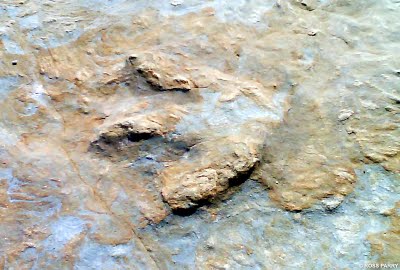
Chinese archeologists said Friday they have exposed an exceptional large track of Dinosaur footprints in a city in the eastern province of Shandong.
After a 3-month excavation, more than 3,000 dinosaur footprints have been exposed on a 2,600-square-meter slope in a gully of Huanghua town in Zhucheng City.
Wang Haijun, a senior engineer at the Institute of Vertebrate Paleontology and Paleoanthropology under the Chinese Academy of Sciences and Xing Lida, a dinosaur footprints researcher, said the prints dated back to more than 100 million years before in the mid Cretaceous period.
The footprints in at least three layers are rare in the world in terms of both their number and entire size, they said.
The footprints, which sort from 10 cm to 80 cm in length, revealed more than six Kinds of Dinosaurs, including Tyrannosaurus, Coelurosaurs and Hadrosaurs.
The footprints were in the same direction. Wang said this might be a effect of migration or panic escape by plant-eating dinosaurs when facing a surprise raid from meat-eating counterparts.
Wang said as excavation persists, there could be more footprint findings.
Archeologists have established dinosaur fossils in some 30 sites in Zhucheng, known as a "dinosaur city".
Zhao Xijin, an expert from the Institute of Vertebrate Paleontology and Paleoanthropology, said Zhucheng exposed the largest Dinosaur Fossil field in the world in 2008 where more than 7,600 fossils had been uncovered.
Monday, February 8, 2010
Roaring beasts bring zoo's dinosaur park to life
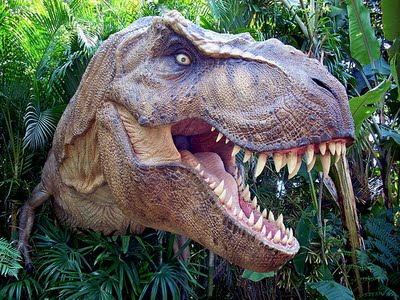
Interactive display lasts until October
It's been about 65 million years since the Albertosaurus roared into town, but the fearsome carnivore has decided it's time to come home.
Dinosaur fans trapped their first glimpse Friday of a temporary Calgary Zoo exhibit that brings to life 20 prehistoric behemoths, including creatures that once stalked Alberta's forests.
The extinct beasts will split their home with the park's original dinosaur residents. As well the Albertosaurus, the giant visitors include a Pachyrhinosaurus -- a "polar dino" that roamed the province in large herds -- and the menacing, massive Allosaurus, known for its sharp teeth and killer claws.
The display -- dubbed Dinosaurs Alive -- is interactive, meaning these predators blink, roar, move their limbs and arrive to life.
Zoo officials expect the exhibit will inject fresh life into Prehistoric Park, built in the 1980s as a tribute to Alberta's rich dinosaur history.
Saturday, February 6, 2010
Tiny dinos died after falling into 160-mln-yr-old deep footprints of larger beasts
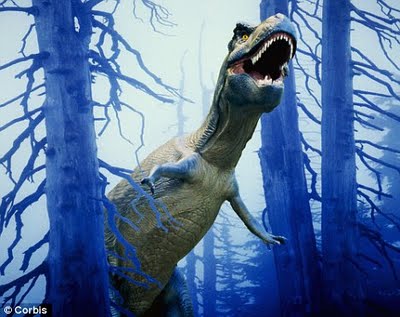
The exceptional Fossil haul of feathered dinosaurs in a 160-million-year-old marsh in China proposes that they perished after falling into the deep muddy footprints of larger beasts.
According to a report in New Scientist, David Eberth of the Royal Tyrrell Museum in Drumheller, Alberta, Canada, established partial skeletons of 18 small two-legged Dinosaurs in the 160-million-year-old sediments.
They were stacked on top of each other, apparently after becoming trapped about circular swampy pits.
The pits enclose distinctive red fragments of crust mixed into the mud.
The palaeontologists reckon this is the effect of large, heavy sauropod feet breaking through a crusty surface layer to watery mud beneath.
A thin crust would have formed hiding the trap from an unsuspecting tiny dinosaur but unable support its weight.
The thin crust would have buried the trap from an unsuspecting small dinosaur.
Fifteen of the fossils were Limusaurus inextricabilis, an odd bipedal dinosaur with tiny arms and a beak.
Even though it belonged to a group of predators it appears to have eaten plants.
"The victims were less than 1 meter tall and 1 to 3 meters long, so they would have been too short to drive against the bottom, which was 1 or 2 meters beneath the surface of the watery mud," said Eberth.
Their arms would have been enveloped with mud-slicked feathers and too small to pull them out of the hole.
"Finding any fossil remains like these, whose presence depends on the activities of other dinosaurs is bizarre." Eberth said.
Labels: Dinosaur eggs, Dinosaur image, Dinosaur model, Dinosaur photo, Dinosaur skeleton
Friday, February 5, 2010
Dinosaur footprints lost with crumbling Bolivia rock face
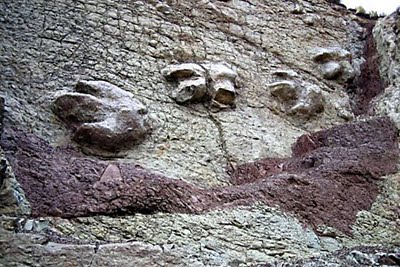
Around 300 Dinosaur footprints believed to be about 65 million years old were lost when the rock wall that contained them cleaved off and crumbled, a Bolivian national park director said Wednesday.
Parque Cretacio director Wilmer Astete informed ATB television that heavy rain and seismic instability had weakened a slab of rock measuring 80 meters (yards) in Cal Orcko, which signifies calcium peak in the Quechua language.
"That rock wall is about 140,000 square meters (1.5 million square feet) and piece of it collapsed. We've missed 300 footprints" made by two titanosaurs, he added.
The Dinosaur tracks were wiped out on Tuesday, Astete said, adding that efforts to safeguard the complete rock wall from fracturing would cost up to 30 million dollars a year, far exceeding the reach of the park administration's budget.
Regardless of the loss, the park remains the site of one of the world's largest collection of dinosaur tracks, Astete said.
Some 5,000 footprints left by 300 Species of dinosaurs from the Cretaceous period (65-145 million years ago) are embedded in the rock face at Cal Orcko, which is situated a few kilometers outside Sucre, Bolivia's constitutional capital.
Local authorities said they were learning plans to protect the archeological site from further damage.
Labels: Dinosaur unit, Dinosour age, Dinosour cartoon, Dinosour family, Dinosour history
Thursday, February 4, 2010
Birds Got Too Fat to Fly After Dinosaurs Vanished?
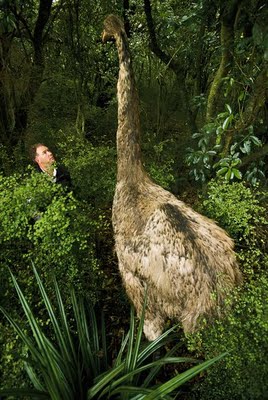
It's been long thought that the ancestors of emus, ostriches and other flightless birds that flew once were flightless too. But a latest study says that they only began exploring the ground in earnest after Dinosaurs were wiped out about 65 million years before.
The unexpected disappearance of dinosaurs opened up new, predator-free niches, where food was plentiful and flight wasn't required for quick escapes, said study leader Matthe Phillips of the Australian National University in Canberra.
The birds then got so plump that they became too heavy to fly, whether they desire or not, the study suggests.
Using Fossil DNA, Phillips and colleagues examined the genome of a giant moa, an extinct flightless bird that lived in what is now New Zealand.
The team establish that the moa's closest relatives were tinamous—small ground-dwelling birds still found in South America that can barely fly.
During most of the Cretaceous period (146 to 65 million years ago), South America, Australia, New Zealand, and Antarctica were joined as part of the massive southern continent Gondwana. About 80 million years before, New Zealand drifted away from Gondwana.
The researchers propose that a moa ancestor may have flown from another location—possibly what would become South America—to New Zealand, where the bird hopped to the ground and eventually evolved into the moa.
Labels: Dinosaur unit, Dinosour age, Dinosour history, Dinosour world
Wednesday, February 3, 2010
Chinasaurs: New dinosaurs with flight
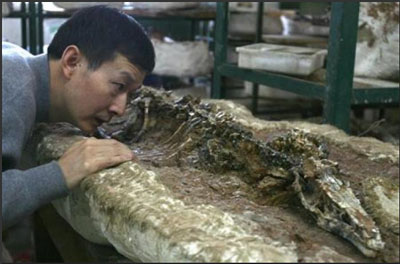
China has made yet another astounding finding that is transforming everything we thought we knew about Dinosaurs - a 160 million-year-old creature that holds the claim that modern day birds are in fact dinosaur descendants.
In a Reuters interview by Dr. Xu, a member of the research team that found out the fossil, as having "unique features... it shares few features with birds. It shifts its hands sideways, like how birds can fold their wings. Its head, hind limbs, vertebral column, hands are all bird-like." That makes it... a lizard parakeet?
The Fossil was discovered in Xinjiang and is a member of the Alvarezsaurs family, this grandpa of a fossil predates all other discoveries by over 63 million years. The fossil shares numerous similar features to birds, but at this point in history was distinctly a dinosaur.
Because it is older than other fossils, it offers an significant link in the evolutionary record showing how birds have slowly developed from dinosaurs. Now we can say with more certainty that our feathered friends are in fact prehistoric living dinosaurs, which is pretty cool.
The fossil is one of 132 latest dinosaurs found by China. Some of our other incredible and long named Dinosaur discoveries comprise a dinosaur with four wings called Anchiornis huxleyi, a gigantic bird raptor called Gigantoraptor Erlianensis and a small feathered dinosaur called epidexipteryx.
Labels: Dinosaur unit, Dinosour age, Dinosour cartoon, Dinosour family, Dinosour history
Tuesday, February 2, 2010
Fossil find in China boosts dinosaur-bird link
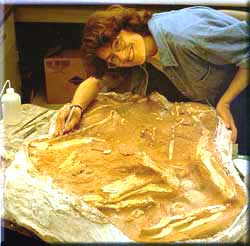
A Dinosaur fossil discovered in northwestern China has gave fresh evidence that although its tribe resembled birds millions of years ago, it must have evolved separately - helping confirm that modern birds are indeed living dinosaurs.
It lived a full 160 million years before in the Jurassic period, long before the feathered Archaeopteryx, the first true flying bird, emerged in the fossil record, scientists said.
The newfound Dinosaur is a member of a group that some scientists had thought evolved into modern-day birds. However, because this fossil is so old, it gives weight to the dominant sight that modern birds, not the newly discovered birdlike creatures in China, were the ones that evolved from dinosaurs.
Like a bird, the dinosaur had 3 toes on each leg, a birdlike keel-shaped chest and a long beak. The ten-foot-long dinosaur, named Haplocheirus sollers or "simple, skillful hand," had short forearms with massive claws.
Labels: Dinosaur footprint, Dinosaur fossils, Dinosour cartoon, Dinosour family
Monday, February 1, 2010
Dinosaur Skin Color Revealed
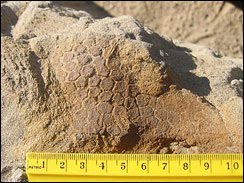
Paleontologists Say Early Dinosaurs had Red "Mohawk" with Red and White Striped Tail
As much as paleontologists have sorted out about the Dinosaurs, one of the chief aspects of their appearance-what color they were-has remained mysterious. But in a new Nature study, a team of British and Chinese scientists report that they establish a way to unlock the color patterns of one of the earliest feathery dinosaurs-it had a red mohawk, they say, with a red and white striped tail.
The dino in question is called Sinosauropteryx, which existed about 125 million years ago. Looking at Fossils originate in China, the team led by Mike Benton found what they think are the remains of feathers. And they found a bit inside the feathers that matches modern birds: melanosomes.
These structures offer the melanin pigment in bird feathers (and human hair), and what color they are depends on the shape. “A ginger-haired person would have more spherical melanosomes, and a black-haired or grey-haired person might have more of the sausage-shaped structures,†said Professor Benton.
Labels: Dinosaur footprint, Dinosaur fossils, Dinosour cartoon, Dinosour family

